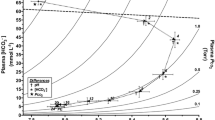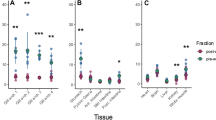Abstract
Pacific hagfish (Eptatretus stoutii) are marine scavengers and feed on decaying animal carrion by burrowing their bodies inside rotten carcasses where they are exposed to several threatening environmental stressors, including hypercapnia (high partial pressures of CO2). Hagfish possess a remarkable capacity to tolerate hypercapnia, and their ability to recover from acid–base disturbances is well known. To deal with the metabolic acidosis resulting from exposure to high CO2, hagfish can mount a rapid elevation of plasma HCO3− concentration (hypercarbia). Once PCO2 is restored, hagfish quickly excrete their HCO3− load, a process that likely involves the enzyme carbonic anhydrase (CA), which catalyzes HCO3− dehydration into CO2 at the hagfish gills. We aimed to characterize the role of branchial CA in CO2/HCO3− clearance from the plasma at the gills of E. stoutii, under control and high PCO2 (hypercapnic) exposure conditions. We assessed the relative contributions of plasma accessible versus intracellular (cytosolic) CA to gill HCO3− excretion by measuring in situ [14C]-HCO3− fluxes. To accomplish this, we employed a novel surgical technique of individual gill pouch arterial perfusion combined with perifusion of the gill afferent to efferent water ducts. [14C]-HCO3− efflux was measured at the gills of fish exposed to control, hypercapnic (48 h) and recovery from hypercapnia conditions (6 h), in the presence of two well-known pharmacological inhibitors of CA, the membrane impermeant C18 (targets membrane bound, plasma accessible CA) and membrane-permeant acetazolamide, which targets all forms of CA, including extracellular and intracellular cytosolic CAs. C18 did not affect HCO3− flux in control fish, whereas acetazolamide resulted in a significant reduction of 72%. In hypercapnic fish, HCO3− fluxes were much higher and perfusion with acetazolamide caused a reduction of HCO3− flux by 38%. The same pattern was observed for fish in recovery, where in all three experimental conditions, there was no significant inhibition of plasma-accessible CA. We also observed no change in CA enzyme activity (measured in vitro) in any of the experimental PCO2 conditions. In summary, our data suggests that there are additional pathways for HCO3− excretion at the gills of hagfish that are independent of plasma-accessible CA.






Similar content being viewed by others
Abbreviations
- CO2 :
-
Carbon dioxide
- HCO3 − :
-
Bicarbonate
- CA:
-
Enzyme carbonic anhydrase
- H+ :
-
Proton
- Hb:
-
Hemoglobin
- CBE:
-
Chloride/bicarbonate exchanger
- RBC:
-
Red blood cell
- PCO2 :
-
Partial pressure of CO2
- SA:
-
Specific activity
- C18:
-
Membrane-impermeant inhibitor of carbonic anhydrase
References
Baker DW, Sardella B, Rummer JL, Sackville M, Brauner CJ (2015) Hagfish: champions of CO2 tolerance question the origins of vertebrate gill function. Sci Rep 5:1–8
Boyle D, Clifford AM, Orr E, Chamot D, Goss GG (2015) Mechanisms of Cl- uptake in rainbow trout: cloning and expression of slc26a6, a prospective Cl-/HCO3- exchanger. Comp Biochem Physiol (a) 180:43–50
Brauner CJ, Shartau RB, Damsgaard C, Esbaugh AJ, Wilson RW, Grosell M (2019) Acid-base physiology and CO2 homeostasis: regulation and compensation in response to elevated environmental CO2. In: Grosell M, Munday PL, Farrell AP, Brauner CJ (eds.) Fish Physiology Vol 37, Elsevier Inc, pp. 69–132.
Claiborne JB, Perry E, Bellows S, Campbell J (1997) Mechanisms of acid-base excretion across the gills of a marine fish. J Exp Zool 279:509–520
Clifford AM, Goss GG, Wilkie MP (2015a) Adaptations of a deep sea scavenger: high ammonia tolerance and active NH4+ excretion by the Pacific hagfish (Eptatretus stoutii). Comp Biochem Physiol (a) 182:64–74
Clifford AM, Weinrauch AM, Goss GG (2018) Dropping the base: recovery from extreme hypercarbia in the CO2 tolerant Pacific hagfish (Eptatretus stoutii). J Comp Physiol B 188:421–435
Clifford AM, Goss GG, Roa JN, Tresguerres M (2015b) Acid/base and ionic regulation in hagfish. In: Edwards, S. L. and Goss, G. G. (eds.) Hagfish Biology, CRC Press pp. 277–292.
Clifford AM, Wilkie MP, Edwards SL, Tresguerres M, Goss GG (2022) Dining on the dead in the deep: active NH4+ excretion via Na+/H+ (NH4+) exchange in the highly ammonia tolerant Pacific hagfish, Eptatretus stoutii. Acta Physiologica, doi:https://doi.org/10.1111/apha.13845.
Cox GK, Sandblom E, Richards JG, Farrell AP (2011) Anoxic survival of the Pacific hagfish (Eptatretus stoutii). J Comp Physiol B 181:361–371
Davenport HW (1974) The ABC of acid-base chemistry: The elements of physiological blood-gas chemistry for medical students and physicians. 6ed. University of Chicago Press, Chicago, IL.
Deigweiher K, Koschnick N, Pörtner HO, Lucassen M (2008) Acclimation of ion regulatory capacities in gills of marine fish under environmental hypercapnia. Am J Physiol Regul Integr Comp Physiol 295:1660–1670
Dichiera AM, Mcmillan OJL, Clifford AM, Goss GG, Brauner CJ, Esbaugh AJ (2020) The importance of a single amino acid substitution in reduced red blood cell carbonic anhydrase function of early-diverging fish. J Comp Physiol B 190:287–296
Ellory JC, Wolowyk MW, Young JD (1987) Hagfish (Eptatretus stoutii) erythrocytes show minimal chloride transport activity. J Exp Biol 129:377–383
Esbaugh AJ, Gilmour KM, Perry SF (2009) Membrane-associated carbonic anhydrase in the respiratory system of the Pacific hagfish (Eptatretus stouti). Respir Physiol Neurobiol 166:107–116
Esbaugh AJ, Heuer R, Grosell M (2012) Impacts of ocean acidification on respiratory gas exchange and acid-base balance in a marine teleost, Opsanus beta. J. Comp Physiol B Biochem Syst Environ Physiol 182:921–934
Forster ME, Fenwick JC (1994) Stimulation of calcium efflux from the hagfish, Eptatretus cirrhatus, gill pouch by an extract of corpuscles of stannius from an eel (Anguilla dieffenbachii): Teleostei. Gen Comp Endocrinol 94(1):92–103
Gilmour KM (2012) New insights into the many functions of carbonic anhydrase in fish gills. Respir Physiol Neurobiol 184:223–230
Gilmour KM, Perry SF (2009) Carbonic anhydrase and acid-base regulation in fish. J Exp Biol 212:1647–1661
Gilmour KM, Perry SF (2010) Gas transfer in dogfish: a unique model of CO2 excretion. Comp Biochem Physiol (a) 155:476–485
Gilmour KM, Shah B, Szebedinszky C (2002) An investigation of carbonic anhydrase activity in the gills and blood plasma of brown bullhead (Ameiurus nebulosus), longnose skate (Raja rhina), and spotted ratfish (Hydrolagus colliei). J Comp Physiol B 172:77–86
Goss GG, Wood CM (1990) Na+ and Cl- uptake kinetics, diffusive effluxes and acidic equivalent fluxes across the gills of rainbow trout. II. Responses to bicarbonate infusion. J Exp Biol 152:549–571
Harter TS, Zanuzzo FS, Supuran CT, Gamperl AK, Brauner CJ (2019) Functional support for a novel mechanism that enhances tissue oxygen extraction in a teleost fish. Proc R Soc B 286:20190339
Heisler N (1984) Acid-base regulation in fishes. In: Hoar WS, Randall DJ (eds.) Fish physiology Vol. 10A (eds), Academic Press. pp. 315–401.
Henry RP, Gilmour KM, Wood CM, Perry SF (1997) Extracellular carbonic anhydrase activity and carbonic anhydrase inhibitors in the circulatory system of fish. Physiol Zool 70:650–659
Hyde BYDA, Perry SF (1987) Acid-base and ionic regulation in the American eel (Anguilla rostrata) during and after prolonged aerial exposure: branchial and renal adjustments. J Exp Biol 133:429–447
Martini FH (1998) The ecology of hagfishes. In: Jorgensen JM, Lomholt JP, Weber RE, Malte H (eds) The biology of hagfishes. Springer, Netherlands Dordrecht, pp 55–75
McDonald DG, Cavdek V, Calvert L, Milligan LC (1991) Acid-base regulation in the atlantic hagfish Myxine glutinosa. J Exp Biol 215:201–215
Mcmillan OJL, Dichiera AM, Wilson JM, Esbaugh AJ, Brauner CJ (2019) Blood and gill carbonic anhydrase in the context of a chondrichthyan model of CO2 excretion. Phys Biochem Zool 92:554–566
Miller WH, Dessert AM, Roblin RO (1950) Heterocyclic sulfonamides as carbonic anhydrase inhibitors. J Am Chem Soc 72:4893–4896
Mussi S, Rezzola S, Chiodelli P, Nocentini A, Supuran CT, Ronca R (2022) Antiproliferative effects of sulphonamide carbonic anhydrase inhibitors C18, SLC00111 and acetazolamide on bladder, gliobastoma and pancreatic cancer cell lines. J Enzyme Inhib Med Chem 37:280–286
Nikinmaa M, Berenbrink M, Brauner CJ (2019) Regulation of erythrocyte function: Multiple evolutionary solutions fo respiratory gas transport and its regulation in fish. Acta Physiol 227:e13299
Parks SK, Tresguerres M, Goss GG (2007) Blood and gill responses to HCl infusions in the Pacific hagfish (Eptatretus stoutii). Can J Zool 85:855–862
Perry SF (1986) Carbon dioxide excretion in fishes. Can J Zool 64:565–572
Rummer JL, Mckenzie DJ, Innocenti A, Supuran CT, Brauner CJ (2013) Root effect hemoglobin may have evolved to enhance general tissue oxygen delivery. Science 340:1327–1329
Scozzafava A, Briganti F, Ilies MA, Supuran CT (2000) Carbonic anhydrase inhibitors: synthesis of membrane-impermeant low molecular weight sulfonamides possessing in vivo selectivity for the membrane-bound versus cytosolic isozymes. J Med Chem 43:292–300
Supuran CT (2008) Carbonic anhydrases: novel therapeutic applications for inhibitors and activators. Nat Rev Drug Discov 7:168–181
Tresguerres M, Parks SK, Goss GG (2006) V-H+-ATPase, Na+/K+-ATPase and NHE2 immunoreactivity in the gill epithelium of the Pacific hagfish (Eptatretus stoutii). Comp Biochem Physiol A 145:312–321
Tresguerres M, Parks SK, Goss GG (2007) Recovery from blood alkalosis in the Pacific hagfish (Eptatretus stoutii): Involvement of gill V-H+ –ATPase and Na+/K+ –ATPase. Comp Biochem Physiol (a) 148:133–141
Tseng YC, Hu MY, Stumpp M, Lin LY, Melzner F, Hwang PP (2013) CO2-driven seawater acidification differentially affects development and molecular plasticity along life history of fish (Oryzias latipes). Comp Biochem Physiol (a) 165:119–1130
Tufts BL, Perry SF (1998) Carbon dioxide transport and excretion. In: Perry SF, Tufts BL (eds) Fish Physiology, vol 17. Academic Press, pp 229–281
Tufts BL, Vincent CJ, Currie S (1998) Different red blood cell characteristics in a primitive agnathan (M. glutinosa) and a more recent teleost (O. mykiss) influence their strategies for blood CO2 transport. Comp Biochem Physiol (a) 119:533–541
Tzaneva V, Gilmour KM, Perry SF (2011) Respiratory responses to hypoxia or hypercapnia in goldfish (Carassius auratus) experiencing gill remodelling. Respir Physiol Neurobiol 175:112–120
Wells RMG, Forster ME, Davidson W, Taylor HH, Davie PS, Satchell GH (1986) Blood oxygen transport in the free-swimming hagfish, Eptatretus cirrhatus. J Exp Biol 123:43–53
Yamaguchi K, Hara Y, Tatsumi K, Nishimura O, Jeramiah JS, Kadota M, Kuraku S (2020) Inference of a genome-wide protein-coding gene set of the inshore hagfish Eptatretus burgeri. bioRxiv. https://doi.org/10.1101/2020.07.24.218818
Acknowledgements
This study was supported by the Natural Sciences and Engineering Research Council of Canada (NSERC) Discovery Grant G.G.G. (#203736). J.M.D. was supported by an NSERC Undergraduate Student Research Award (USRA). The authors wish to acknowledge two anonymous reviewers whose invaluable comments have greatly improved our manuscript. We would like to thank Drs. Eric Clelland and Tao Eastham (Bamfield Marine Sciences Centre research coordinators) and the BMSC research and animal care supporting staff for excellent and invaluable support.
Author information
Authors and Affiliations
Corresponding author
Additional information
Communicated by B. Pelster.
Publisher's Note
Springer Nature remains neutral with regard to jurisdictional claims in published maps and institutional affiliations.
Rights and permissions
Springer Nature or its licensor holds exclusive rights to this article under a publishing agreement with the author(s) or other rightsholder(s); author self-archiving of the accepted manuscript version of this article is solely governed by the terms of such publishing agreement and applicable law.
About this article
Cite this article
Giacomin, M., Drummond, J.M., Supuran, C.T. et al. The roles of plasma accessible and cytosolic carbonic anhydrases in bicarbonate (HCO3−) excretion in Pacific hagfish (Eptatretus stoutii). J Comp Physiol B 192, 713–725 (2022). https://doi.org/10.1007/s00360-022-01459-0
Received:
Revised:
Accepted:
Published:
Issue Date:
DOI: https://doi.org/10.1007/s00360-022-01459-0




